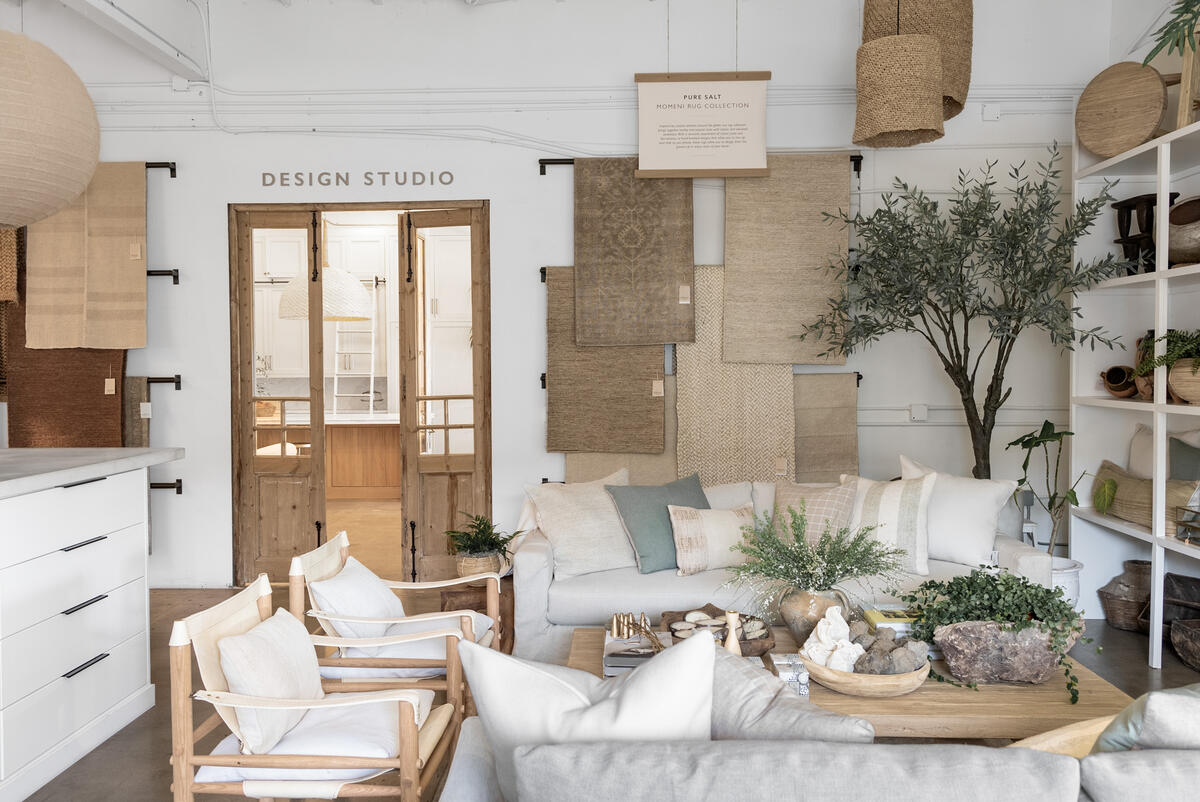In the fall of 2021, the height of the pandemic home boom, Business of Home published a guide for designers looking to get into e-commerce. The article, down to its lighthearted title—“Everything you ever wanted to know about e-commerce (but were afraid to ask)”—reflected the digital gold rush spirit of the time. Everyone was buying furniture and decor, and they were all doing it online. Shouldn’t designers get in on the action?
Many did. Whether through affiliate deals, drop-shipping sites, tools like SideDoor, or simply stocking pillows and candles in spare rooms, designers found a way to do some kind of business online. Those who had been in the game before Covid grew; meanwhile, pandemic spin-ups got traction fast. For many designers, it was sweet vindication: After years of responding to Insta DMs about where to buy a side table, they could finally sell one themselves.
Three years later, the gold rush is over. E-commerce retailers like Bellacor, Burke Decor and Food52 are struggling or shuttering. Meanwhile, two of the industry’s brightest stars, Justina Blakeney and Athena Calderone, recently announced they were closing down their online stores to focus on other pursuits. Everywhere you look, it seems like designers are quietly removing the Shop tab from their websites.
It’s fair to ask: Has e-commerce entered its flop era?
TOUGH CONDITIONS
Obvious, but worth saying: No part of the home industry is doing particularly well at the moment, online or off. Every week it seems like another 100-year-old family furniture store shutters, or a venerable North Carolina manufacturer announces layoffs. Still, e-commerce has its own flavor of pain.
To begin with, online shopping overall has slumped since the peak of the pandemic. Between 2019 and 2021, buying activity shot up rapidly, going from 10 percent of U.S. retail sales to almost 17 percent. Futurists boldly predicted that the e-commerce future was inevitable, and brick-and-mortar was over. However, since then, the percentage has mostly stayed flat, even dipping from quarter to quarter. Home goods specifically have had it worse.

“We were cautiously optimistic that in the spring of ’24, we’d start comping last year. 2023 was super soft compared to 2022, so we thought we’d start hitting those numbers,” says Calla Murphy, senior vice president of digital strategy at Belardi Wong, a retail marketing agency with high-profile clients in the home business. “That has not been the case. … In April, home decor e-commerce is down 14 percent year over year. We pulled the numbers for May and it’s the same [decrease].”
Belardi Wong’s data, says Murphy, suggests that sellers who run both e-commerce operations and stores are seeing business shift to in-person shopping. Amid the overall digital softness is another shift: The big brands—those doing over $25 million in annual revenue—are faring far better than the smaller ones online.
There’s no single explanation for that. Partially, it may be that larger companies simply have more data, more customers and more ability to make the most of bad market conditions. It’s also fair to wonder if pivots made by the tech giants are playing a role. In the world of physical retail, landlords can be difficult, but if one raises the rent—well, there are other storefronts. There are, however, no other Googles or Facebooks. When one of the massive platforms makes a change or raises prices for ad campaigns, it can hit harder for small players.
Among the major changes of the past two years: Apple’s blocking of ad trackers, spiking the cost of ads on Instagram and Facebook; Google’s recent price hikes and its embrace of multimedia Performance Max campaigns that allow down-market brands to flood the zone with dupes and cheap look-alikes … The list goes on.
“Marketing’s not getting any cheaper. And a 10 percent increase on the cost of every click in Google—that’s tough to ingest for a smaller brand,” says Murphy. “Bigger brands are able to pivot quickly, they’ve got more people looking at [platform shifts]. …Ten grand for a marketing spend is nothing for them. It’s a rare thing for an emerging brand.” (It may be a “never” thing for a designer running a Shopify-powered site.)
Designers have also been hit particularly hard by another tech giant’s recent contortions. As Instagram has tweaked its platform to try to keep up with TikTok, emphasizing Reels and algorithmically recommended content, this has almost inevitably dragged eyeballs away from our industry. Designers could once reliably count on Instagram as a marketing channel. Now even reaching a fraction of your followers isn’t guaranteed—making it more difficult to sell either services or a side table.
Many of these changes were underway during the pandemic. But at the time, the overwhelming demand for home goods made it easy to whip up an e-commerce shop and get sales anyway. Now that overall demand has subsided, the challenges of the ecosystem are coming sharply into focus.
DESIGNERS WEIGH THE ODDS
For a company that does nothing but sell online, these are dark times. For individual designers, who have mostly treated e-commerce like a side hustle, the picture is a little bit different. Very few have bet so deeply on it that a 10, 20 or even 60 percent drop in online sales would push their firm into financial tragedy. As a result, the reaction to choppy waters isn’t outright panic, but a kind of soul-searching: In a softer market, is this even worth doing?
Add a post-pandemic desire to slow down, simplify and catch a breath—and the answer, in some cases, is no. “It just started to get very robust and needed a lot of machinery and people and energy just to keep it going,” Blakeney told host Dennis Scully on a recent episode of The Business of Home Podcast. “All of a sudden it went from running an art and design firm, where most of my time and energy went to creative things, to a lot of time with marketing teams and A/B testing. … When that really became the heart of the business, it started to drain me.”
The hustle-and-bustle of it all is very much a motivating factor. While e-commerce seems to offer the potential of low-stress income—No rent to pay! No sales associates to employ!—the reality is that selling goods online can quickly become complex and costly.
“Once Covid hit, the orders started flowing in, and we were just hiring more and more people—it was fast and furious,” says Aly Morford of the Newport, California–based firm Pure Salt. Morford and her partner, Leigh Lincoln, had always known they wanted to develop a retail component to their business, and had started selling online well before the pandemic. But the rocket-fueled growth of the home boom had them rapidly upgrading to a 15,000-square-foot warehouse for inventory and expanding their team from around 10 to more than 35 in order to accommodate the flood of orders.

Morford and Lincoln have no intention of leaving e-commerce behind. But now that the Covid boom has died down, they’re handing off the fulfillment component of their online store to a third-party provider. “What we’ve come to terms with this year is that we need to simplify that side of the business. The operations, the shipping, the importing—there are a lot of layers,” says Morford. “We want to keep it running, but we don’t want it to pull us away from what we’re here to do, which is design.”
Even drop-shipping sites, where designers hold no inventory, can be complicated. Fairfax, Virginia–based designer DuVäl Reynolds spun up an e-commerce site as a stand-alone business in 2022. Though House of DuVäl operates entirely on a drop-shipping model, Reynolds says the process of setting up and maintaining the site—which involves coordinating with vendors, writing endless copy and communicating with customers—has been time-consuming.
“When you get into it, you quickly realize a few things,” says the designer. “One is that it’s not free—there’s a lot of pay-to-play [with the tech platforms]. The other is that you need someone to run it full-time.”
The first illusion of e-commerce is that it’s easy. The second is that it’s risk-free. The hidden danger of selling goods online will be a familiar one to designers: Vendors don’t always come through, and customers get upset. But on a project, where designers have leverage with their suppliers and an intimate relationship with the purchasers, late merchandise and broken product can often be managed away. If you’re selling to strangers on the open internet, all bets are off.
Vendors, who are often juggling hundreds if not thousands of accounts, have bigger fish to fry. Customers can get angry and lose their heads. One bad experience with the wrong shopper, and designers can face an onslaught of nasty social media comments and online reviews, tarnishing their firm’s reputation. Even if it never turns ugly, the reality is that quality control in e-commerce is a moving target.
“We have explored several mediums and methods for sharing products outside of our design projects over the years, but few e-commerce platforms have allowed us to deliver on the exceptional, [as you have] less control over consistent quality and experience,” says St. Louis designer Amy Studebaker, who has experimented with online retail over the years but recently pulled back. “Nothing is off the table—sometimes it’s just a matter of throwing things out there to see what sticks. What sticks now might not stick in the future, and that's what keeps things interesting around here!”

THE LONG GAME
A reality check: We may be in the middle of a slump, but no one is predicting terminal decline for online sales. Far from it. Just last week, research giant Forrester unveiled a prediction that e-commerce in the U.S. will grow at a steady rate over the next four years, reaching $1.6 trillion by 2028, or 28 percent of overall retail sales (a number that is currently just under 16 percent). Even if that rapid growth doesn’t come to pass, the general consensus is that online sales will go up, not down.
What’s more, the housing market will eventually thaw, consumers will splurge on furniture and decor again, and the home industry will break out of the post-pandemic doldrums. Designers who find a way to stick it out, stand out from the crowd and reach consumers online are poised to reap the benefits—eventually.
It’s probably best to understand this period as a time of recalibration, not a retreat. The era of doing e-commerce “just because” is waning, and those who are in it for the long haul are strategizing a new approach. Morford and Lincoln of Pure Salt have been looking at ways to double down on their strengths. “We’re really focusing on doing bigger business with the vendors we’re working with—that opens up pathways for creating your own product, things that are not available to other vendors or designers. That’s one piece that’s been super successful for our brand,” says Morford. “Products that are available everywhere—I mean, people can Google-shop those things all day long. It’s just a harder game to play.”
And while there’s no denying that many designers are moving away from e-commerce, that migration creates more opportunity for the ones who can find a successful niche. Though Reynolds has kept his e-store on the backburner in recent months, a few big-ticket sales came in recently, causing him to speculate. “It seems like something that could work for us,” he says. “If we jump on it.”




























